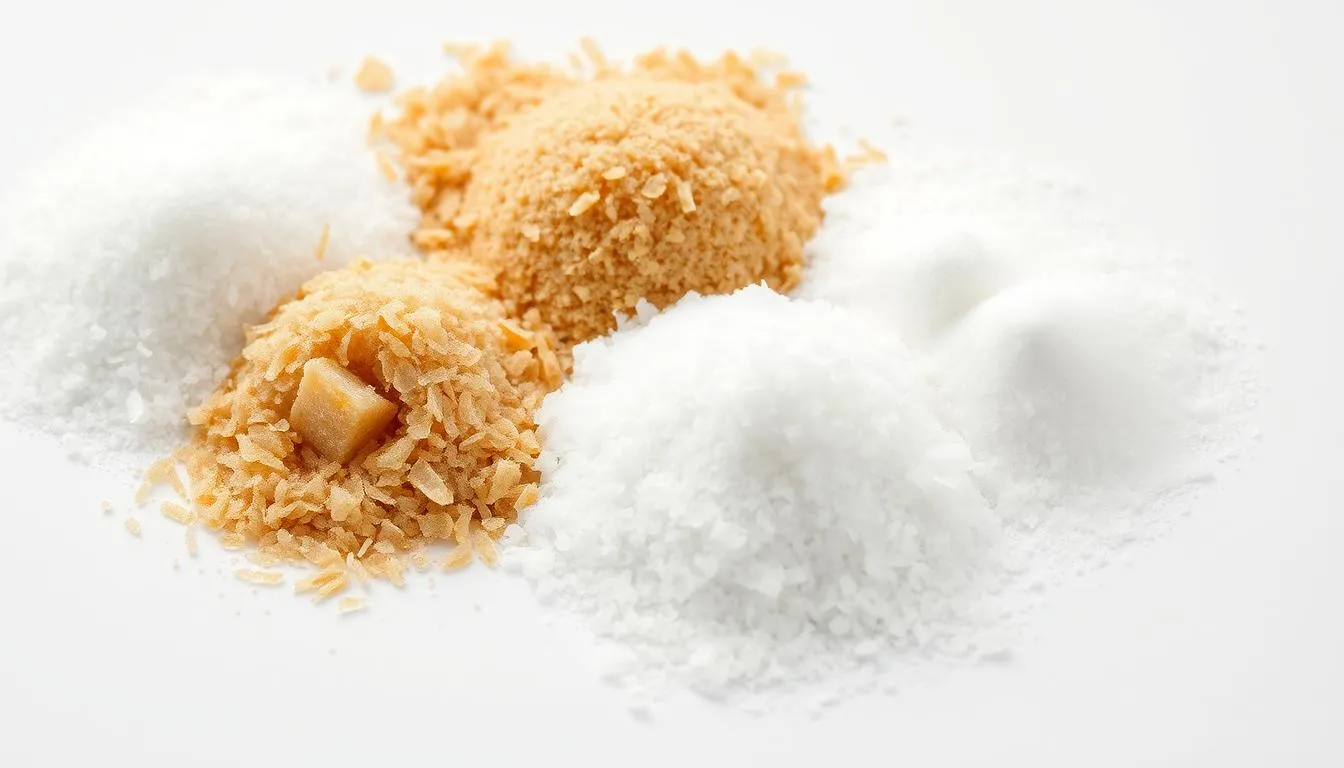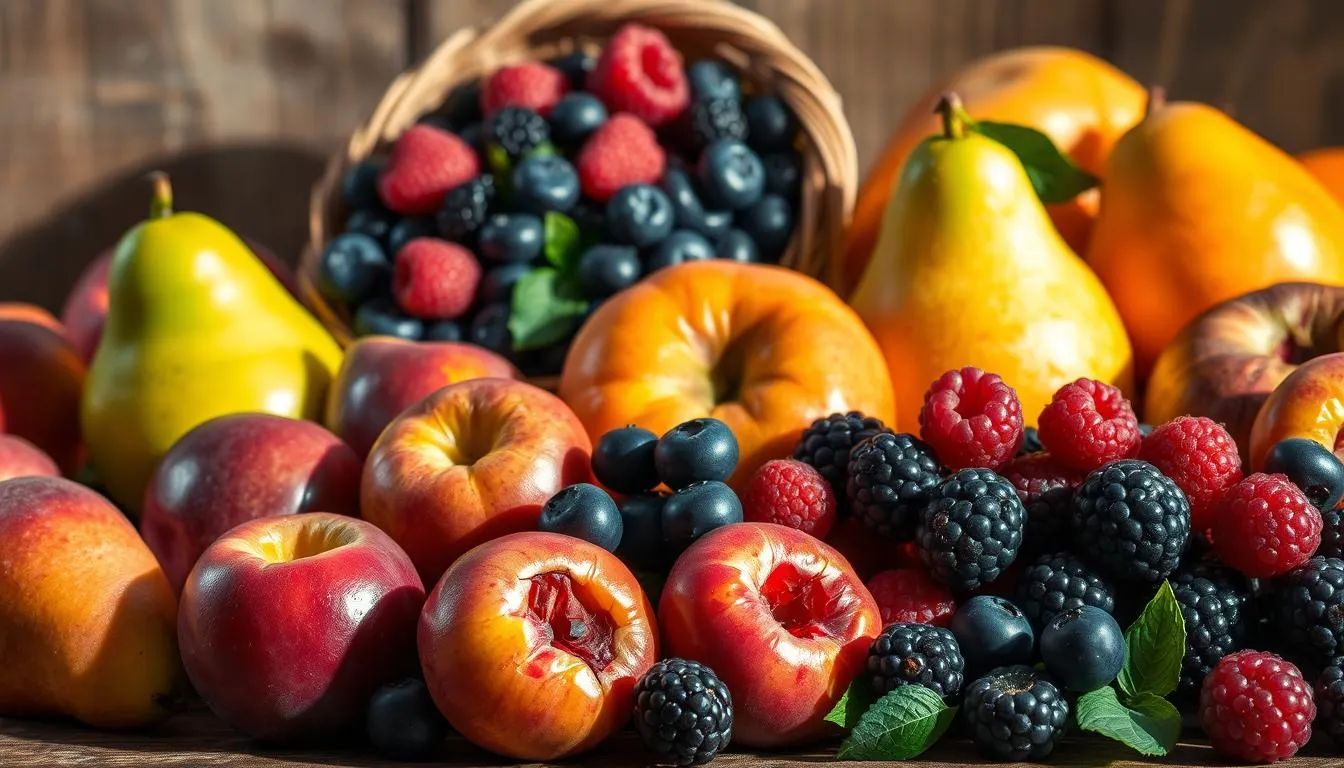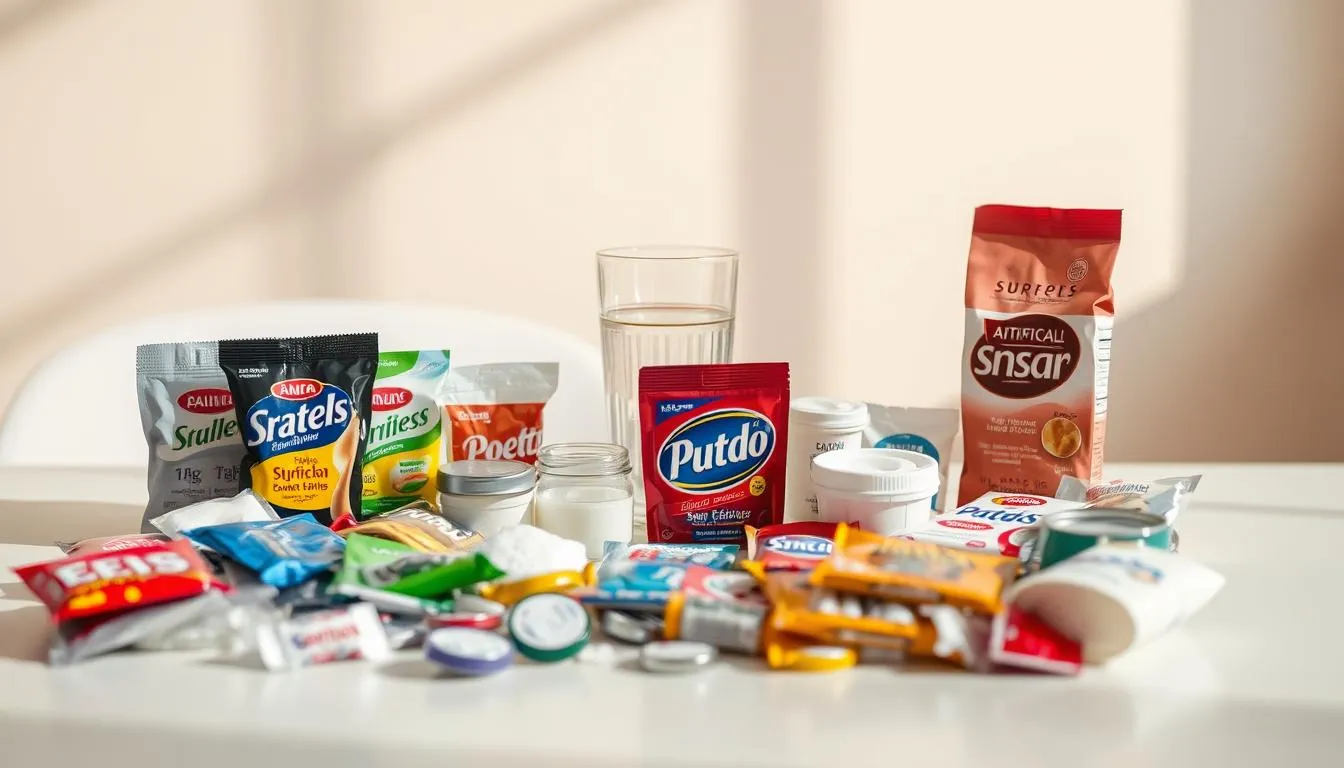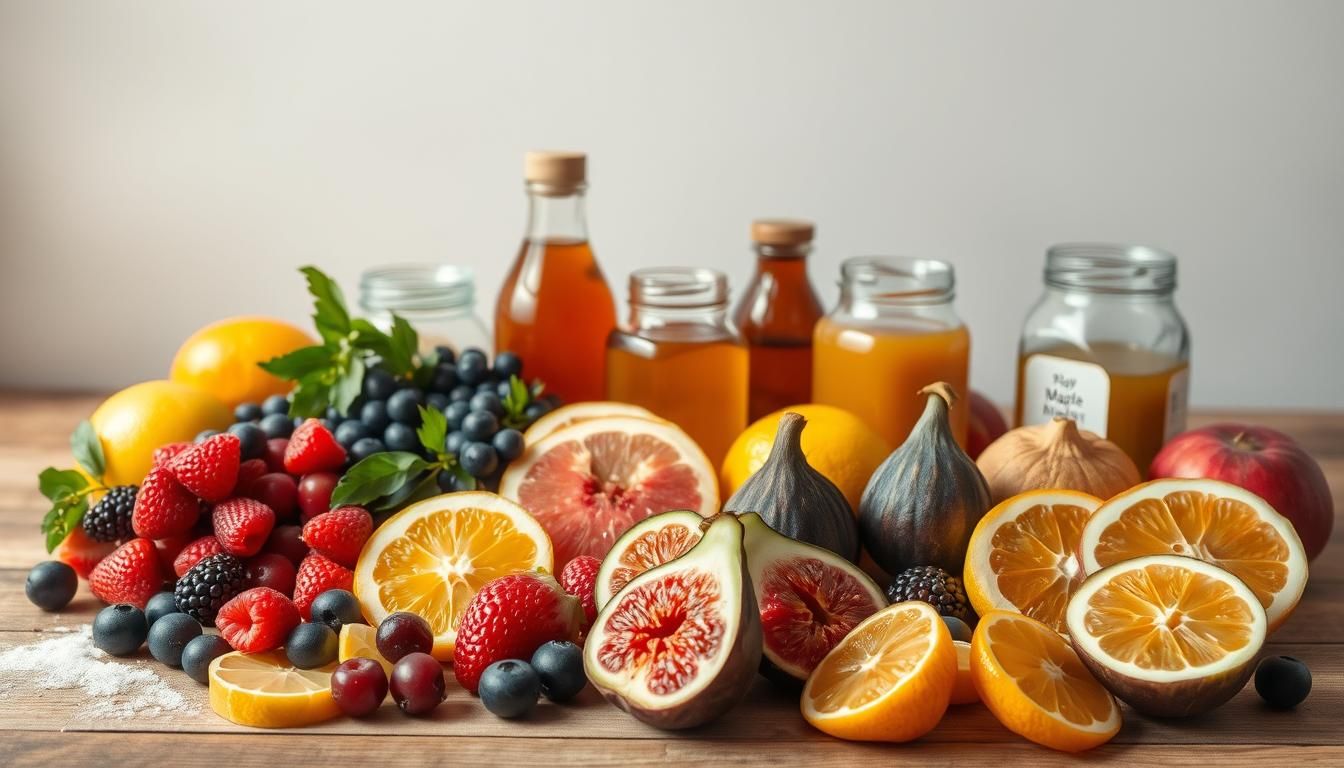I remember the first time I swapped my afternoon cookie for fruit it felt like a small act, but it changed my afternoons. This guide is for people who want to enjoy sweetness without the overwhelm. Well show friendly, practical product choices that fit real life.
Keeping added sugar low supports long-term health. Too much intake links to obesity, Type 2 diabetes, heart disease, and fatty liver. Many packaged foods and drinks hide large amounts, so simple label savvy matters.
Think of this roundup as a toolkit: whole-fruit sweetening ideas, plant-based sweeteners, better beverage swaps, and unsweetened staples for cooking and coffee. Youll get quick, usable tips for oatmeal, yogurt, smoothies, and more choices that keep flavor and texture intact.
Well also cover label basics and the role of different sweeteners so you know what you need to know before you buy. For an evidence-based primer on added sugars and sweeteners, see this trusted overview.
Key Takeaways
- Small swaps can cut consumption and support better health over time.
- Favor whole foods and smart product choices that taste good.
- Learn to read labels to spot hidden sugars in common foods and drinks.
- Try multiple options to match taste, budget, and routine.
- Focus on steady improvements, not perfection.
What reduced sugar really means right now: added sugars, labels, and health basics
Labels can be confusing; a quick primer on added and natural sugars clears things up fast.
Added sugars are ingredients put into foods during processing or preparation. They are common in sodas, flavored yogurts, cereals, sauces, and many packaged goods. These sugars raise calories without adding fiber or vitamins, and regular high intake links to obesity, Type 2 diabetes, and heart disease.

Added sugar vs. natural sugar
Natural sugar in fruit and dairy comes with fiber, protein, and micronutrients. That package slows digestion and helps steady blood sugar.
Daily limits and label tips
The American Heart Association suggests about 25 grams per day for women and 36 grams per day for men. The average U.S. intake is roughly 68 grams per day, so small cuts matter.
- Scan labels for terms like highfructose corn syrup, cane syrup, or concentrates.
- Watch for added sugars in dressings, breads, and prepared sauces.
- Choose whole foods first; use sweeteners and substitutes sparingly.
| Item | Why it matters | What to look for |
|---|---|---|
| Flavored yogurt | Often high in added sugars | Check for syrups, cane sugar, total added sugars |
| Cereals | Hidden sugars boost calories | Compare grams per serving and ingredients list |
| Sauces & dressings | Concentrated sources of sweeteners | Scan for corn syrup, fructose, concentrates |
Reducedsugar alternatives to try today: our product roundup of smarter sweeteners and swaps
Simple pantry choices help you enjoy sweetness while trimming added calories.
Best overall pick: fresh or frozen fruit tops the list. Add mashed banana or unsweetened applesauce to oatmeal. Stir blueberries into plain Greek yogurt. Blend frozen cherries into smoothies. Fruit adds fiber, vitamin C, potassium, and antioxidants while boosting flavor.

Plantbased sweeteners to try
Stevia extracts work well in coffee and tea. Use them sparingly and pair with milk or spices for a more sugarlike taste.
Monk fruit and how to use it
Monk fruit has a clean sweetness that suits iced tea, lattes, and quick breads. Blended monk fruit products often measure more like sugar for baking.
Novel sweeteners to watch
Allulose and tagatose behave more like sugar in baking and frozen treats. They brown and add bulk, so try small test batches to dial texture and moisture.
Everyday buying tips and beverage swaps
Buy unsweetened yogurt, oatmeal, and cereal, then add fruit so you control sweetness and nutrition. For drinks, infuse water with sliced berries or citrus, try unsweetened iced tea, or dilute juice halfandhalf with water.
- Boost perceived sweetness with cinnamon, vanilla, or citrus zest.
- Cut sweetener graduallyreduce coffee/tea by a quarter and adjust weekly.
- Test small baking batches when using new sweetener products.
| Option | Best uses | Nutrition & notes |
|---|---|---|
| Fresh or frozen fruit | Oatmeal, yogurt, smoothies, water infusions | Adds fiber, vitamins, antioxidants; controls calories |
| Stevia (extract forms) | Coffee, tea, some beverages, lowcalorie recipes | Plantbased sweetener; use sparingly for best flavor |
| Monk fruit blends | Beverages, baking, lattes | Clean taste; blended forms measure more like sugar |
| Allulose / Tagatose | Ice creams, cookies, chilled desserts | Functional like sugar; brown and add bulk in baking |
Use with caution: natural sugars, artificial sweeteners, and sugar alcohols
Choosing a sweetener calls for a clear-eyed look at benefits and risks. Natural options can add flavor and tiny nutrients, but they still count as added sugar and calories. Read labels and think about how each choice affects blood sugar and long-term health.

Natural sweeteners: honey, maple syrup, and agave
Raw honey and pure maple syrup contain antioxidants and trace oligosaccharides. Still, they are caloriedense and will raise blood sugar, so use them sparingly.
Check labels: some products labeled as maple syrup include highfructose corn syrup or corn syrup blends. If you watch intake for diabetes or weight, count these as added sugars.
Spotting hidden sugars on labels
Scan ingredient lists for terms that signal added sweeteners. Avoid products with highfructose corn syrup and watch serving sizes sugars add up across foods.
Artificial sweeteners and what studies say
FDAapproved artificial sweeteners (acesulfame potassium/AceK, aspartame, sucralose, saccharin, neotame) are intensely sweet and lowcalorie. The FDA considers them safe for intended use, but longterm metabolic and heart outcomes remain under study.
A balanced approach is wise: use them to cut calories, but monitor cravings and overall sweetness in your diet.
Sugar alcohols: benefits and GI risks
Sugar alcohols like erythritol, xylitol, and sorbitol lower net sugars in recipes and drinks. They can cause bloating, gas, or diarrhea for some people.
Recent observational data linked higher erythritol levels with heart events, so test tolerance and use these substitutes mindfully while research continues.
- Treat natural sweeteners as added sugar that can raise blood sugar.
- Read labels to avoid hidden corn syrup and blended syrups.
- Introduce new sweeteners slowly and watch digestion and cravings.
| Type | Key points | When to use |
|---|---|---|
| Natural (honey, maple syrup) | Antioxidants, calories; counts as added sugar | Small amounts for flavor |
| Artificial sweeteners | Lowcalorie; FDAapproved; longterm studies ongoing | To reduce calories, use moderately |
| Sugar alcohols | Lower sugar impact; possible GI side effects; erythritol links under study | Test tolerance; good for some baked or frozen treats |
How to cut back without feeling deprived: simple steps for a lesssweet diet
Small shifts to daily habits make a big difference in how sweet your meals feel.
Start small: trim one teaspoon of sweetener from your coffee or tea each week. This gradual change helps your palate adjust without pain. Swap one soda or sweet tea for water or unsweetened iced tea on practice days.
Buy unsweetened yogurt, oatmeal, and cereal and stir in fresh or frozen fruit. Dilute juice halfandhalf with water when you want flavor but fewer calories and lower sugar intake.
- Begin with easy wins: cut a little sweetener from drinks each week so your taste adapts.
- Let drinks work harderchoose water, sparkling water, or unsweetened tea; try halfjuice/halfwater for flavor.
- Shop smart: pick unsweetened products, then add fruit, cinnamon, or vanilla for depth without added sugar.
- Use substitutes and sugar substitutes selectively; reserve artificial sweeteners for moments you need an extra lift.
- Plan balanced meals with protein, fiber, and healthy fats so cravings drop and overall intake stays steady.
Read labels every time. Hidden added sugar in foods can nudge blood sugar, daily sugar intake, and weight goals. For practical tips on how to eat less, see this eat less guide.
Conclusion
Small, consistent swaps add up to big changes in how your food tastes and fuels you.
Favor whole fruit and plain bases first to get natural sweetness, fiber, and better overall nutrition. Use unsweetened yogurt, oatmeal, and beverages so you control how much sweetness you add.
Try natural sweeteners like stevia or monk fruit in moderation and reach for maple syrup sparingly when a recipe needs a more sugarlike touch. Check labels to avoid highfructose corn syrup and hidden syrups that inflate calories and added sugar.
Keep portions mindful and focus on steady reductions. Over time, lower sugar intake can support weight goals and reduce risks tied to obesity, diabetes, and heart healthprogress beats perfection.
FAQ
What does “reduced-sugar” mean on a food label?
“Reduced-sugar” generally means the product has at least 25% less added sugar than a comparable item. Labels can list added sugars separately from naturally occurring sugars found in fruit and dairy. Check the Nutrition Facts panel and the ingredient list for words like cane syrup, corn syrup, or high-fructose corn syrup to spot hidden sweeteners.
How do added sugars differ from natural sugars in fruit and dairy?
Natural sugars occur inside whole foods like fruit and milk and come with fiber, vitamins, or protein that slow absorption. Added sugars are put into foods during processing or preparation and provide calories with little nutrition. Choosing whole fruit or plain yogurt keeps beneficial nutrients while lowering added sweeteners.
What daily limits for added sugars do experts recommend?
The American Heart Association suggests no more than about 6 teaspoons (25 grams) per day for women and 9 teaspoons (36 grams) for men. These limits focus on added sugars, not the natural sugars in fruit or milk.
What are good whole-food sweetener swaps for cereal and yogurt?
Fresh or frozen fruitberries, banana slices, or cooked applesadds sweetness plus fiber and vitamins. Toasted nuts, cinnamon, or a small drizzle of nut butter also increase flavor without relying on added sweeteners.
How can I use stevia and other plant-based sweeteners?
Stevia and leaf-based extracts provide intense sweetness with no calories. Start with a small amount and adjust, since concentrated stevia can taste bitter for some. It works well in beverages, yogurt, and many baked goods when combined with bulk ingredients like applesauce or mashed banana.
What makes monk fruit different from other zero-calorie sweeteners?
Monk fruit extract delivers sweetness without raising blood sugar and tends to have a cleaner aftertaste than some artificial sweeteners. It pairs nicely with coffee, tea, and many recipes; use blended monk fruit products designed for baking for more predictable volume and browning.
Should I try newer sweeteners like allulose and tagatose?
Allulose and tagatose are low-calorie sugars that behave more like table sugar in baking and freezing. They can brown and provide bulk but may cause digestive upset in large amounts. Use them in recipes designed for these ingredients and start with smaller portions.
Which everyday items should I buy unsweetened to cut intake?
Opt for unsweetened yogurt, plain oatmeal, and unsweetened plant milks and cereals. Then add fruit or a dash of cinnamon for flavor. This reduces added sugars and gives you control over sweetness and calories.
What are healthy beverage swaps to reduce sweet drinks?
Try water infusions with citrus or berries, diluted 100% fruit juice, sparkling water, or unsweetened iced tea. These deliver flavor without the high added-sugar content of sodas and many commercial drinks.
Are natural sweeteners like honey and maple syrup better for health?
Honey and maple syrup contain small amounts of minerals and antioxidants, but they still add calories and raise blood glucose similarly to table sugar. Use them sparingly and account for their calories when managing weight or diabetes.
How can I spot hidden sweeteners on labels?
Read ingredients for terms such as corn syrup, high-fructose corn syrup, dextrose, maltose, sucrose, and fruit juice concentrates. “No added sugars” differs from “unsweetened,” so check the Nutrition Facts for grams of added sugars per serving.
What does current research say about artificial sweeteners like aspartame and sucralose?
The FDA has approved several artificial sweeteners as safe for general use. Research continues on long-term metabolic and gut effects; most health agencies recommend moderate use and choosing whole-food flavors whenever possible.
Are sugar alcohols safe, and do they affect digestion or heart health?
Sugar alcohols such as erythritol, xylitol, and sorbitol provide fewer calories than sugar. Erythritol is better tolerated, while others can cause gas or diarrhea in sensitive people. Some studies have explored links between certain sweeteners and cardiovascular risk, so discuss concerns with your clinician if you have heart disease risk factors.
How can I cut back on sweeteners without feeling deprived?
Start small: reduce the sweetener you add to coffee or tea, choose unsweetened versions of packaged foods, and build flavor with spices, citrus zest, and whole fruits. Gradual changes help taste buds adapt and make shifts sustainable.
